Abstract
1 A study has been made of the pharmacology of 5-hydroxytryptamine (5-HT)-induced hyperpolarization responses recorded extracellularly from the rat isolated superior cervical ganglion (SCG). 2 Hyperpolarization responses induced by 5-HT (1 X 10(-8)-1 X 10(-4) M) in the presence of MDL 72222 (1 X 10(-5) M) were not antagonized by phentolamine (1 X 10(-6) M), prazosin (1 X 10(-7)-3 X 10(-7) M), haloperidol (1 X 10(-6) M) or ketanserin (1 X 10(-7)-1 X 10(-6) M). However, the latter two compounds both potentiated and increased the persistence of the hyperpolarization induced by moderate to high concentrations of 5-HT. Spiperone (1 X 10(-7) M) caused similar effects. All further experiments were performed in the presence of ketanserin (1 X 10(-6) M) as well as MDL 72222. 3 8-Hydroxy-2(di-n-propylamino)-tetralin (8-OH-DPAT; 1 X 10(-7)-1 X 10(-4) M) and ipsapirone (3 X 10(-5)-3 X 10(-4) M) behaved as weak hyperpolarizing agonists on the SCG. However, at concentrations below those required to produce hyperpolarization, both compounds acted as unsurmountable antagonists of 5-HT-induced hyperpolarization. 4 5-Carboxamidotryptamine (5-CT; 1 X 10(-9)-1 X 10(-5) M) mimicked the hyperpolarizing activity of 5-HT on the SCG. The EC50 for 5-CT was approximately 9 fold lower than that for 5-HT. 5 Spiperone (1 X 10(-7) - 1 X 10(-5) M) behaved as a reversible competitive antagonist of hyperpolarization responses induced by 5-HT with a pKB value of 7.40 +/- 0.09. Spiperone (1 X 10(-7)-1 X 10(-6) M) also caused concentration-dependent rightward displacement of the 5-CT concentration-hyperpolarization response curve. In this case, the pKB was 7.80 +/- 0.05. 6 (+/-)-Cyanopindolol (3 X 10(-7)-3 X 10(-6) M) caused non-parallel rightward displacements of the 5-HT concentration-response curve. Against 5-CT, (+/-)-cyanopindolol (3 X 10(-7)-3 X 10(-6) M) caused a concentration-independent rightward displacement of the concentration-response curve, accompanied by a large increase in the maximum response. 5-CT-induced hyperpolarization recorded in the presence of (+/-)-cyanopindolol (3 X 10(-7) M) was not significantly antagonized by methiothepin (1 X 10(-6) M) or methysergide (1 X 10(-6) M). 7 It is concluded that 5-HT-induced hyperpolarization of the rat SCG is mediated via a 5-HT1-like receptor which resembles the 5-HT1A binding site.(ABSTRACT TRUNCATED AT 400 WORDS)
Full text
PDF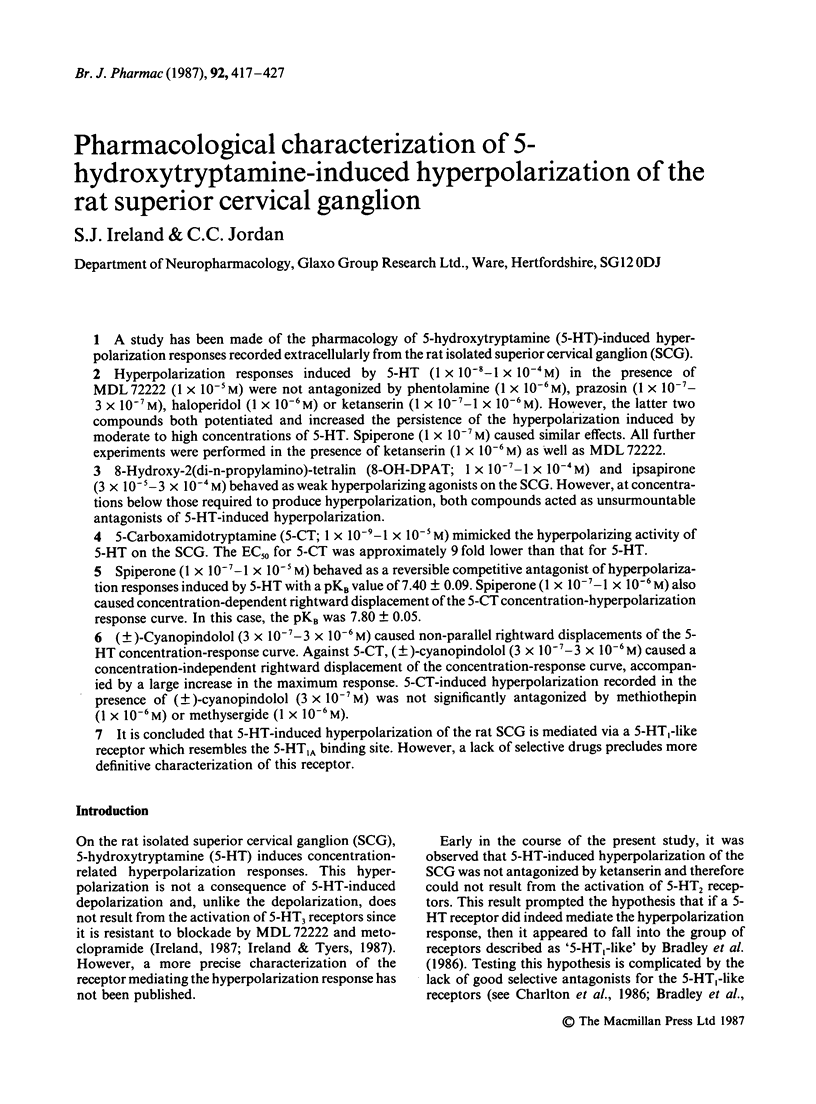

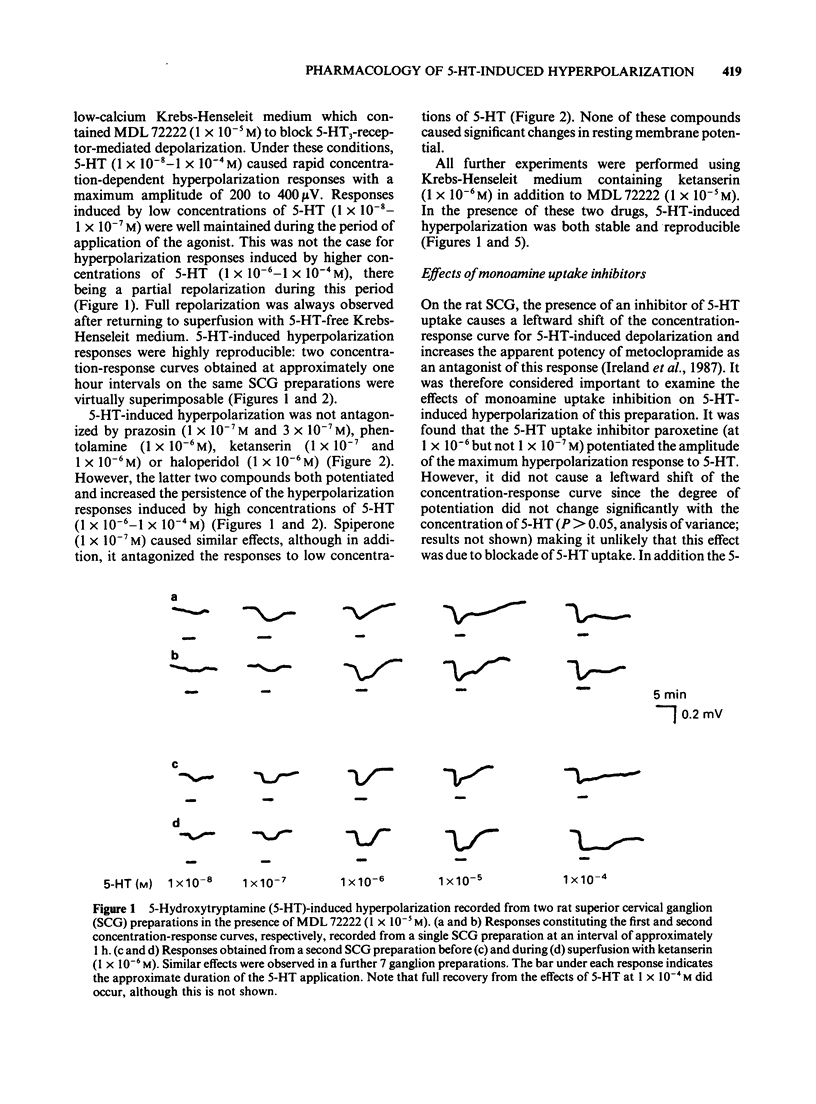

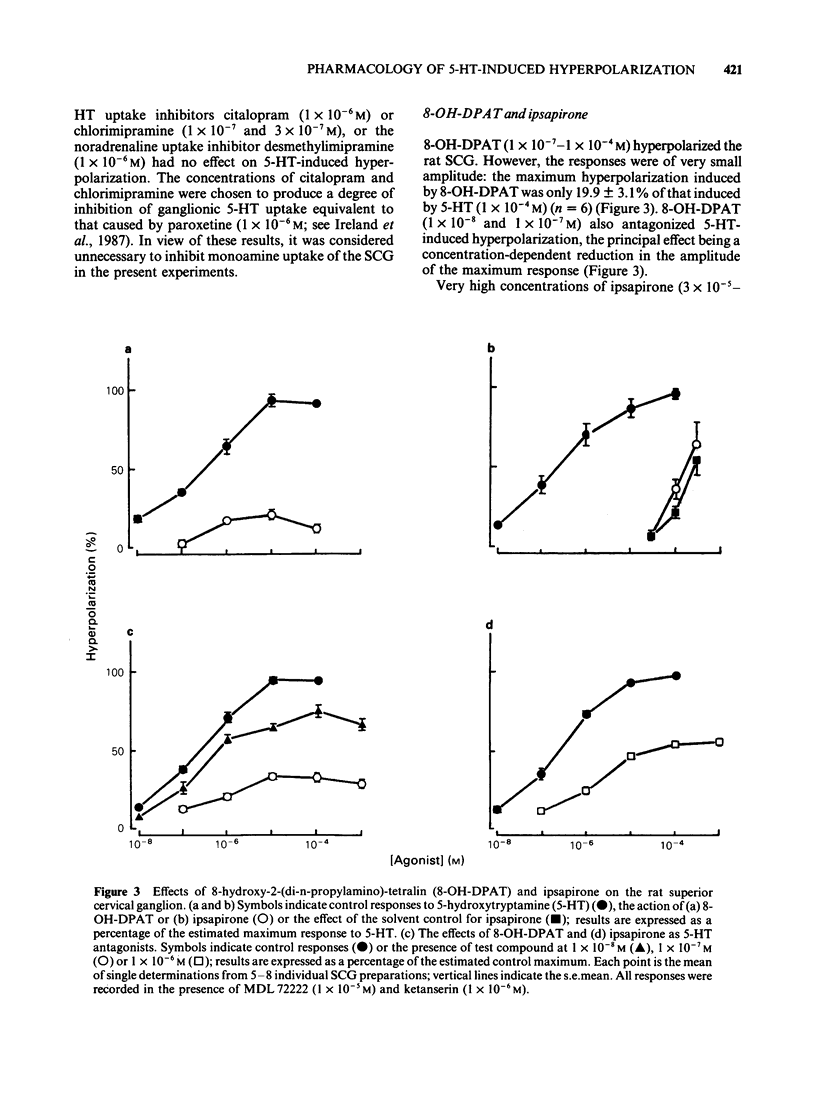
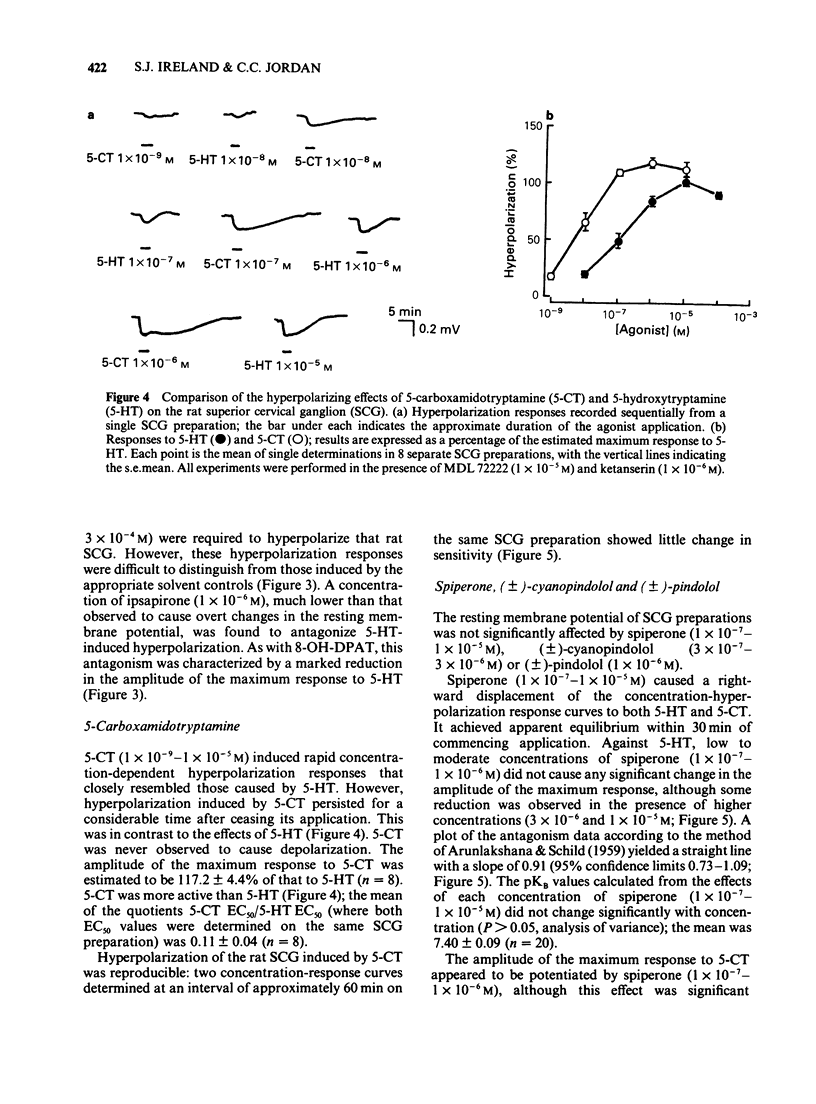
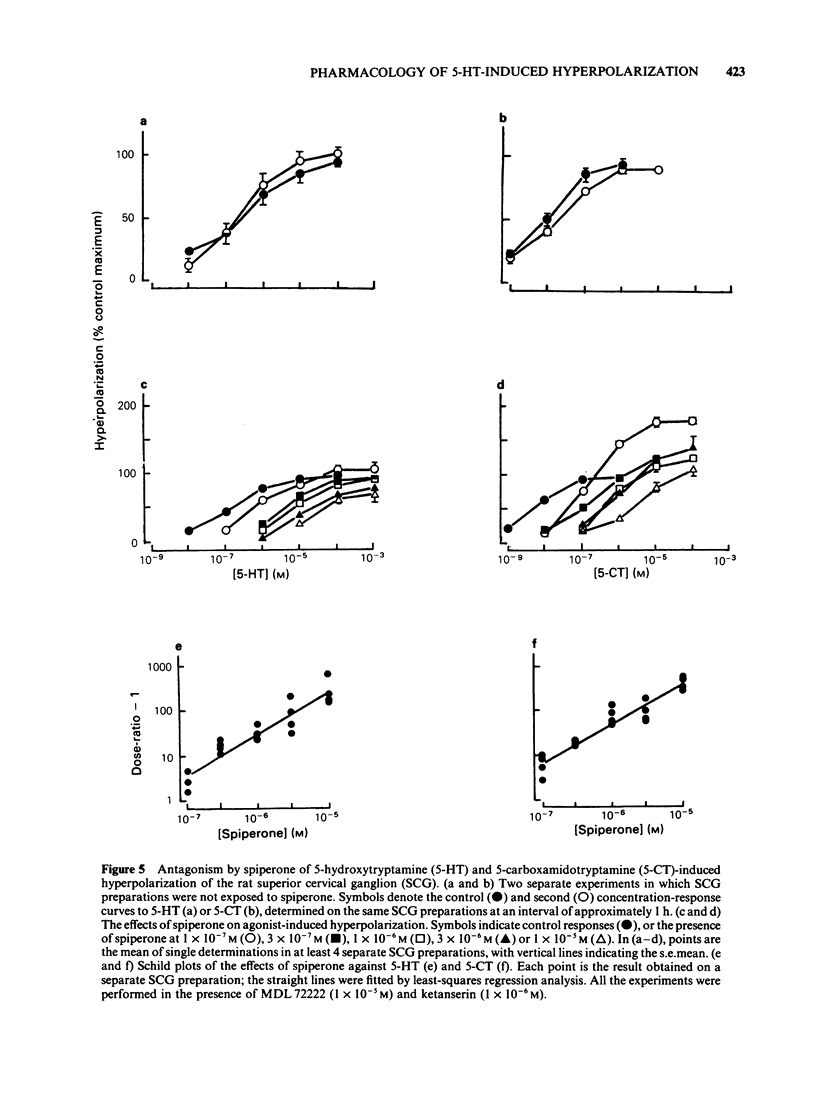
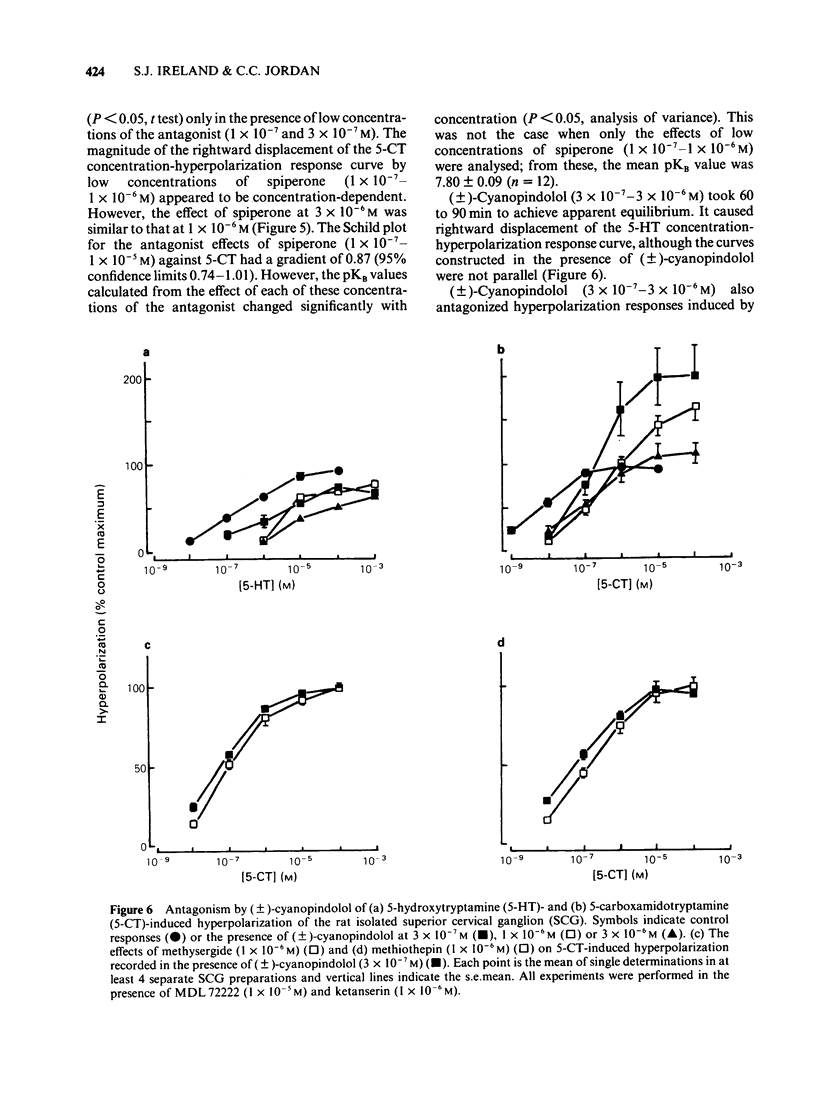
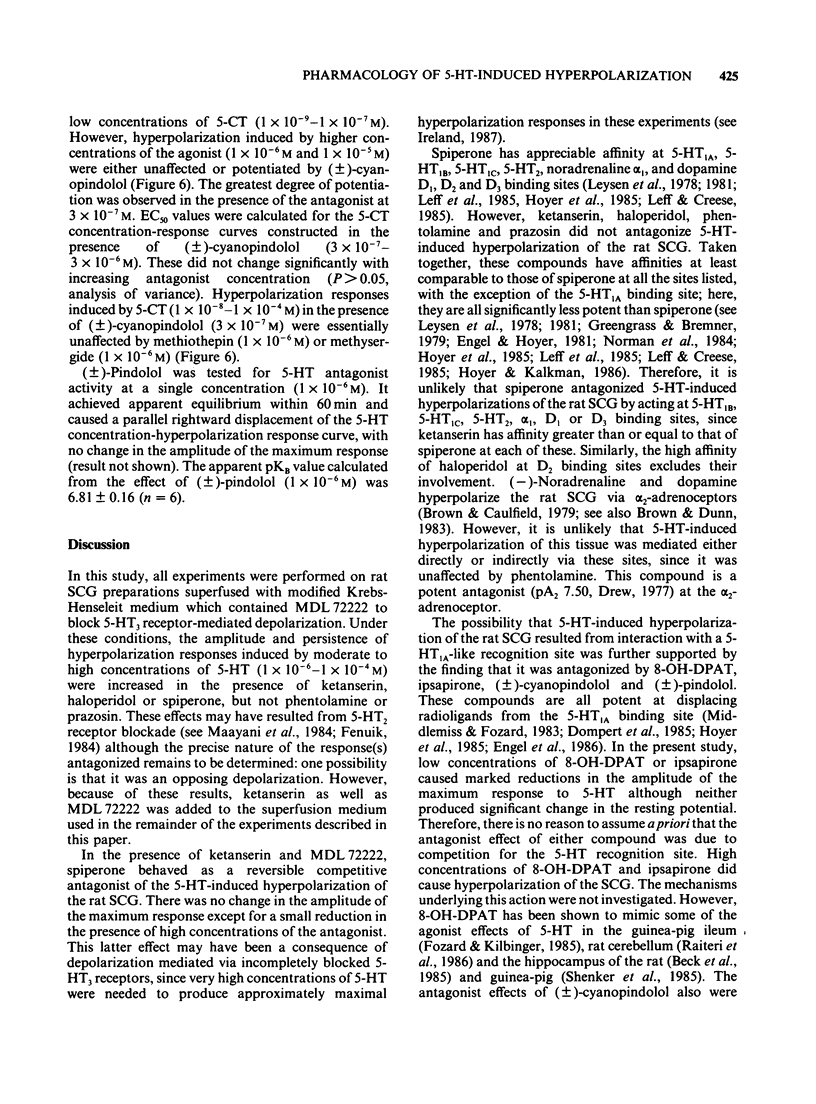
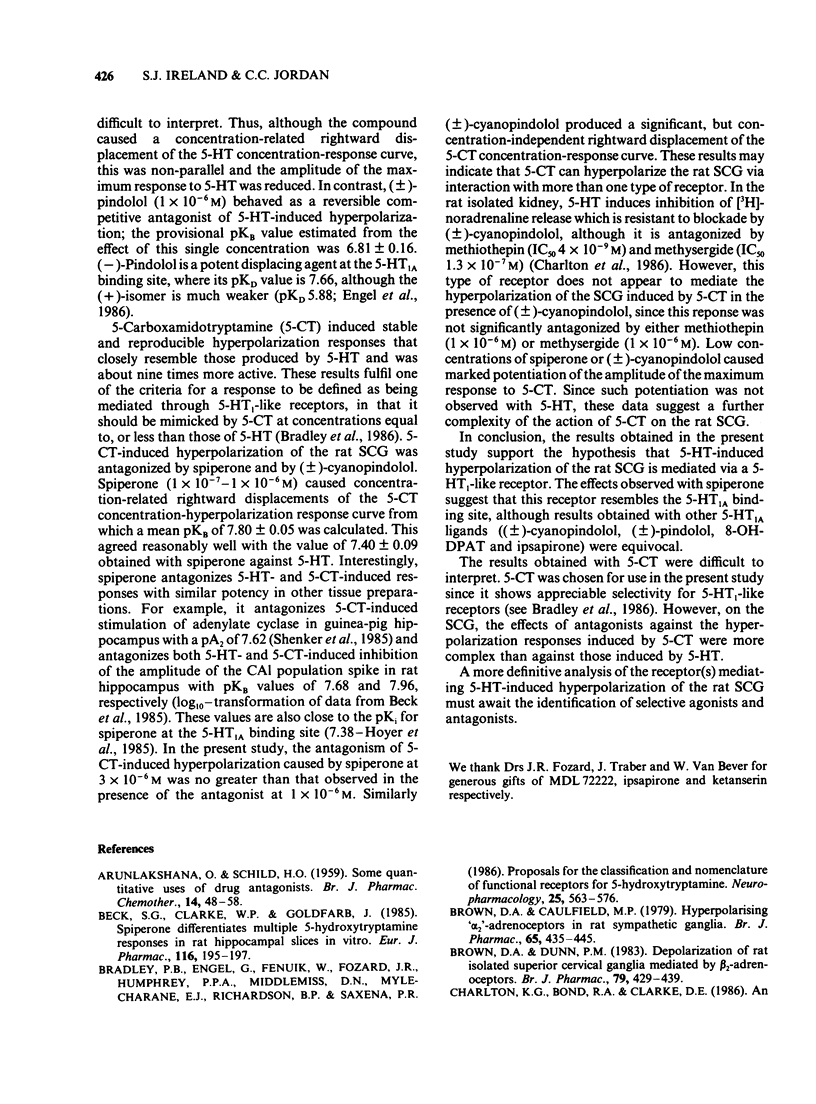
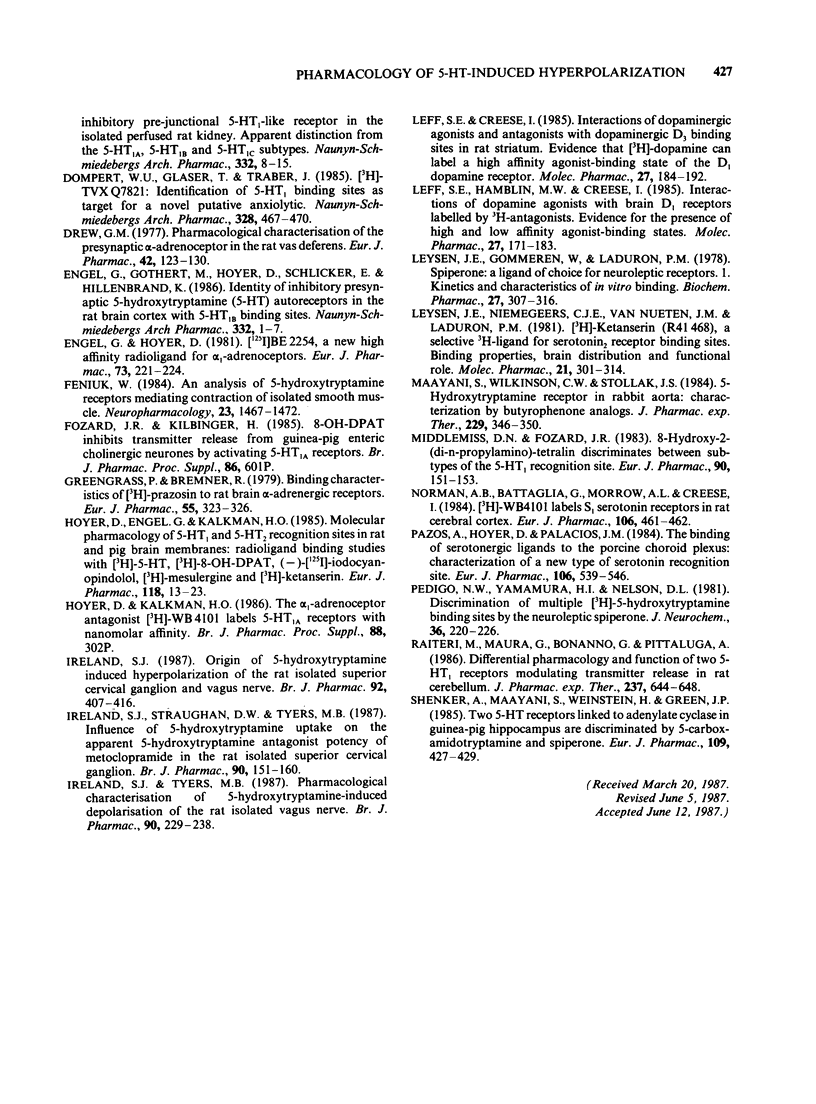
Selected References
These references are in PubMed. This may not be the complete list of references from this article.
- ARUNLAKSHANA O., SCHILD H. O. Some quantitative uses of drug antagonists. Br J Pharmacol Chemother. 1959 Mar;14(1):48–58. doi: 10.1111/j.1476-5381.1959.tb00928.x. [DOI] [PMC free article] [PubMed] [Google Scholar]
- Beck S. G., Clarke W. P., Goldfarb J. Spiperone differentiates multiple 5-hydroxytryptamine responses in rat hippocampal slices in vitro. Eur J Pharmacol. 1985 Oct 8;116(1-2):195–197. doi: 10.1016/0014-2999(85)90206-7. [DOI] [PubMed] [Google Scholar]
- Bradley P. B., Engel G., Feniuk W., Fozard J. R., Humphrey P. P., Middlemiss D. N., Mylecharane E. J., Richardson B. P., Saxena P. R. Proposals for the classification and nomenclature of functional receptors for 5-hydroxytryptamine. Neuropharmacology. 1986 Jun;25(6):563–576. doi: 10.1016/0028-3908(86)90207-8. [DOI] [PubMed] [Google Scholar]
- Brown D. A., Caulfield M. P. Hyperpolarizing 'alpha 2'-adrenoceptors in rat sympathetic ganglia. Br J Pharmacol. 1979 Mar;65(3):435–445. doi: 10.1111/j.1476-5381.1979.tb07848.x. [DOI] [PMC free article] [PubMed] [Google Scholar]
- Brown D. A., Dunn P. M. Depolarization of rat isolated superior cervical ganglia mediated by beta 2-adrenoceptors. Br J Pharmacol. 1983 Jun;79(2):429–439. doi: 10.1111/j.1476-5381.1983.tb11016.x. [DOI] [PMC free article] [PubMed] [Google Scholar]
- Charlton K. G., Bond R. A., Clarke D. E. An inhibitory prejunctional 5-HT1-like receptor in the isolated perfused rat kidney. Apparent distinction from the 5-HT1A, 5-HT1B and 5-HT1C subtypes. Naunyn Schmiedebergs Arch Pharmacol. 1986 Jan;332(1):8–15. doi: 10.1007/BF00633190. [DOI] [PubMed] [Google Scholar]
- Dompert W. U., Glaser T., Traber J. 3H-TVX Q 7821: identification of 5-HT1 binding sites as target for a novel putative anxiolytic. Naunyn Schmiedebergs Arch Pharmacol. 1985 Feb;328(4):467–470. doi: 10.1007/BF00692918. [DOI] [PubMed] [Google Scholar]
- Drew G. M. Pharmacological characterisation of the presynaptic alpha-adrenoceptor in the rat vas deferens. Eur J Pharmacol. 1977 Mar 21;42(2):123–130. doi: 10.1016/0014-2999(77)90351-x. [DOI] [PubMed] [Google Scholar]
- Engel G., Göthert M., Hoyer D., Schlicker E., Hillenbrand K. Identity of inhibitory presynaptic 5-hydroxytryptamine (5-HT) autoreceptors in the rat brain cortex with 5-HT1B binding sites. Naunyn Schmiedebergs Arch Pharmacol. 1986 Jan;332(1):1–7. doi: 10.1007/BF00633189. [DOI] [PubMed] [Google Scholar]
- Engel G., Hoyer D. [125I]BE 2254, a new high affinity radioligand for alpha 1-adrenoceptors. Eur J Pharmacol. 1981 Jul 17;73(2-3):221–224. doi: 10.1016/0014-2999(81)90095-9. [DOI] [PubMed] [Google Scholar]
- Feniuk W. An analysis of 5-hydroxytryptamine receptors mediating contraction of isolated smooth muscle. Neuropharmacology. 1984 Dec;23(12B):1467–1472. doi: 10.1016/0028-3908(84)90090-x. [DOI] [PubMed] [Google Scholar]
- Greengrass P., Bremner R. Binding characteristics of 3H-prazosin to rat brain alpha-adrenergic receptors. Eur J Pharmacol. 1979 May 1;55(3):323–326. doi: 10.1016/0014-2999(79)90202-4. [DOI] [PubMed] [Google Scholar]
- Hoyer D., Engel G., Kalkman H. O. Molecular pharmacology of 5-HT1 and 5-HT2 recognition sites in rat and pig brain membranes: radioligand binding studies with [3H]5-HT, [3H]8-OH-DPAT, (-)[125I]iodocyanopindolol, [3H]mesulergine and [3H]ketanserin. Eur J Pharmacol. 1985 Nov 26;118(1-2):13–23. doi: 10.1016/0014-2999(85)90658-2. [DOI] [PubMed] [Google Scholar]
- Ireland S. J. Origin of 5-hydroxytryptamine-induced hyperpolarization of the rat superior cervical ganglion and vagus nerve. Br J Pharmacol. 1987 Oct;92(2):407–416. doi: 10.1111/j.1476-5381.1987.tb11337.x. [DOI] [PMC free article] [PubMed] [Google Scholar]
- Ireland S. J., Straughan D. W., Tyers M. B. Influence of 5-hydroxytryptamine uptake on the apparent 5-hydroxytryptamine antagonist potency of metoclopramide in the rat isolated superior cervical ganglion. Br J Pharmacol. 1987 Jan;90(1):151–160. doi: 10.1111/j.1476-5381.1987.tb16835.x. [DOI] [PMC free article] [PubMed] [Google Scholar]
- Ireland S. J., Tyers M. B. Pharmacological characterization of 5-hydroxytryptamine-induced depolarization of the rat isolated vagus nerve. Br J Pharmacol. 1987 Jan;90(1):229–238. doi: 10.1111/j.1476-5381.1987.tb16844.x. [DOI] [PMC free article] [PubMed] [Google Scholar]
- Leff S. E., Creese I. Interactions of dopaminergic agonists and antagonists with dopaminergic D3 binding sites in rat striatum. Evidence that [3H]dopamine can label a high affinity agonist-binding state of the D1 dopamine receptor. Mol Pharmacol. 1985 Feb;27(2):184–192. [PubMed] [Google Scholar]
- Leff S. E., Hamblin M. W., Creese I. Interactions of dopamine agonists with brain D1 receptors labeled by 3H-antagonists. Evidence for the presence of high and low affinity agonist-binding states. Mol Pharmacol. 1985 Feb;27(2):171–183. [PubMed] [Google Scholar]
- Leysen J. E., Gommeren W., Laduron P. M. Spiperone: a ligand of choice for neuroleptic receptors. 1. Kinetics and characteristics of in vitro binding. Biochem Pharmacol. 1978 Feb 1;27(3):307–316. doi: 10.1016/0006-2952(78)90233-2. [DOI] [PubMed] [Google Scholar]
- Leysen J. E., Niemegeers C. J., Van Nueten J. M., Laduron P. M. [3H]Ketanserin (R 41 468), a selective 3H-ligand for serotonin2 receptor binding sites. Binding properties, brain distribution, and functional role. Mol Pharmacol. 1982 Mar;21(2):301–314. [PubMed] [Google Scholar]
- Maayani S., Wilkinson C. W., Stollak J. S. 5-Hydroxytryptamine receptor in rabbit aorta: characterization by butyrophenone analogs. J Pharmacol Exp Ther. 1984 May;229(2):346–350. [PubMed] [Google Scholar]
- Middlemiss D. N., Fozard J. R. 8-Hydroxy-2-(di-n-propylamino)-tetralin discriminates between subtypes of the 5-HT1 recognition site. Eur J Pharmacol. 1983 May 20;90(1):151–153. doi: 10.1016/0014-2999(83)90230-3. [DOI] [PubMed] [Google Scholar]
- Norman A. B., Battaglia G., Morrow A. L., Creese I. [3H]WB4101 labels S1 serotonin receptors in rat cerebral cortex. Eur J Pharmacol. 1984 Nov 13;106(2):461–462. doi: 10.1016/0014-2999(84)90743-x. [DOI] [PubMed] [Google Scholar]
- Pazos A., Hoyer D., Palacios J. M. The binding of serotonergic ligands to the porcine choroid plexus: characterization of a new type of serotonin recognition site. Eur J Pharmacol. 1984 Nov 27;106(3):539–546. doi: 10.1016/0014-2999(84)90057-8. [DOI] [PubMed] [Google Scholar]
- Pedigo N. W., Yamamura H. I., Nelson D. L. Discrimination of multiple [3H]5-hydroxytryptamine binding sites by the neuroleptic spiperone in rat brain. J Neurochem. 1981 Jan;36(1):220–226. doi: 10.1111/j.1471-4159.1981.tb02397.x. [DOI] [PubMed] [Google Scholar]
- Raiteri M., Maura G., Bonanno G., Pittaluga A. Differential pharmacology and function of two 5-HT1 receptors modulating transmitter release in rat cerebellum. J Pharmacol Exp Ther. 1986 May;237(2):644–648. [PubMed] [Google Scholar]
- Shenker A., Maayani S., Weinstein H., Green J. P. Two 5-HT receptors linked to adenylate cyclase in guinea pig hippocampus are discriminated by 5-carboxamidotryptamine and spiperone. Eur J Pharmacol. 1985 Mar 12;109(3):427–429. doi: 10.1016/0014-2999(85)90408-x. [DOI] [PubMed] [Google Scholar]


